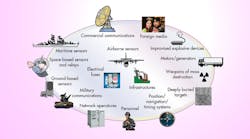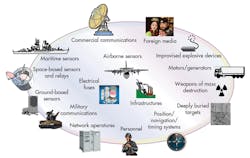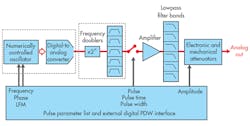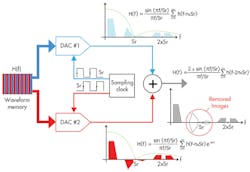Signal-Generation Advances Support Electronic Warfare’s Evolution
This file type includes high resolution graphics and schematics when applicable.
Modern electronic warfare (EW) makes use of the latest RF/microwave technologies to attack, defend, and enhance strategic operations. To enable these applications, highly complex and integrated computer/radio systems are needed to keep the military on the cutting edge. This advancement comes with the price of even more advanced methods of testing and signal generation, which calibrate, refine, and verify the operation of these highly capable radio weapons, armor, and tools.
If the military could deploy EW instead of kinetic weapons, the cost of engagements could be dramatically lowered. The necessary supply lines to support the ammunition required in a traditional engagement also could be cut. For example, the U.S. military Tomahawk (which The Economist claims cost $1.5 million per missile) and the Hellfire air-to-ground rocket (estimated at a cost of $115,000 per rocket) can now be used in large numbers during engagements. On September 23 of this year, the Washington Post reported that 47 Tomahawk missiles were fired overnight between two U.S. warships in the Persian Gulf and the Red Sea. Other examples can be found in the defense of U.S. assets—for example, the $70 billion price tag on the F-22 Raptor fighter aircraft program. Obviously, the use of such assets could be greatly reduced if it were possible to instead eliminate an opponent’s ability to coordinate and communicate between forces while maintaining our forces’ communications capability.
Substituting EW weapons and techniques could enable the military to do the following: effectively eliminate a target through electrical attack, reduce/eliminate the effectiveness of an opponent’s attack, or strategically outmaneuver an opponent through superior communication or resource denial (Fig. 1). Within each of these scenarios is an opportunity to implement RF EW with units that incur predominantly up-front expenses. For example, an active-electronically-steered-array (AESA)-based jammer may cost hundreds of millions of dollars initially to develop and millions more to deploy. Yet the residual costs may be minimal in comparison to current kinetic-weapons technology.
The U.S. Navy and other branches are investing heavily in technology to provide electronic attack, protection, and warfare support (Fig. 2). To enable these technologies, software-defined radios (SDRs), cognitive networking, and radars based upon antenna arrays are being implemented. These technologies have begun to utilize more cost-effective commercial-off-the-shelf (COTS) technology. They also take advantage of the latest high-performing materials, such as gallium nitride (GaN). These new technologies raise performance while adding a wide range of capabilities.
To take greatest advantage of these benefits, however, these devices require more advanced signal-generation technology. “The modern spectral threat environment contains thousands of emitters—radios, wireless devices, and tens to hundreds of radar threats—producing millions of radar pulses per second amidst background signals and noise,” says Shawn McCann, EW Business Development Manager for Keysight Technologies. “Recreating this environment in the laboratory is a major challenge, often involving a number of different types of signal-generation tools.”
Traditionally, large, complex rack-mount cabins would be necessary to present a large enough number of RF sources to emulate true-to-war conditions. An example of this is Northrop Grumman’s Combat Electromagnetic Environment Simulator (CEESIM). Although it is a highly capable instrument, the CEESIM is not within the budget or footprint requirements of many radar test scenarios and therefore cannot be applied to most real-world tests. Recent technology advances, such as direct digital synthesis (DDS)/direct carrier generation (DCG) of RF signals, have enabled the emulation of highly complex radar signatures in more compact and cost-effective forms (Fig. 3).
DDS leverages the capability of modern circuitry to operate at sampling rates that have reached RF frequencies. With an ideal arbitrary waveform generator (AWG), a signal up to half of the sampling rate can be produced with sufficient accuracy to enable directly generated, modulated RF. In the past, low spurious-free-dynamic-range (SFDR) and sampling rates prevented AWGs from producing greater than a few gigahertz.
With the latest AWG technologies, however, there are signal generators capable of 20 GHz and even 40 GHz and bandwidths from 160 MHz to 14 GHz from companies like Rohde & Schwarz, Tektronix, and Keysight. Many of these signal generators are capable of complex modulation including multiple-input/multiple-output (MIMO), phased array, and rapid switching between modes in as little as nanoseconds. McCann notes, “Advancements in DDS source technology with a lower spurious and noise floor have enabled the latest EW signal-generation technologies. Modern digital interfaces for efficient EW threat environments support the need for millions of pulse descriptor words (PDWs) per second. Wider instantaneous bandwidths are required for the generation of complex spectral scenarios. In addition, multiple synchronized channels are needed to simulate signals for systems using multiple or phased-array antenna systems.”
This file type includes high resolution graphics and schematics when applicable.
DAC Innovation
This file type includes high resolution graphics and schematics when applicable.
Although material developments have increased circuitry performance, clever techniques are still being developed to significantly enhance the present technology for signal generation. An example of an advanced DDS technique is Tektronix’s AWG70001 dual-DAC architecture, which enables extended AWG range using two matched digital-to-analog converters (DACs) (Fig. 4). The first DAC has the odd samples delivered to it, while the second DAC has the even samples applied. A delay of half of the sampling period must be applied to the second DAC in order to cancel the images from each DAC. This approach prevents those images from appearing in the second Nyquist band. According to Tektronix, this approach enhances a DDS structure to run at two times the sampling rate instead of half the sampling rate of a single DAC architecture.
Yet there are limitations to DDS technology. The record length (RL) of a radar signal limits a time window in inverse proportion to the sampling rate. For higher sampling rates, the RL time window is therefore shortened. Yet the RL remains critical for simulating real-world and diverse radar signals and environmental factors. With a long RL, for example, the effects of physical vibration, acceleration, echo characteristics, frequency-hopping pattern, and staggered pulse sequences can all be included in simulation. The result is more effective radar calibration.
Other advances also have pushed the boundaries of EW signal generation. “With EW systems, the main technology advancements have been modern digital signal processing (DSP), higher-performance analog-to-digital converters (ADCs)/DACs, and software-defined system architectures,” says McCann. “On the EW-simulator side, advancements have been enabled by the following: core DAC performance, nano-field-effect-transistor (nano-FET) switching, 40-GHz agile attenuators, real-time pulse generation, Ethernet interfaces, simulator angle-of-attack (AoA) calibration/verification methods, and threat reactivity based on behavioral models.”
Cognitive-networking technologies also may be applied to the modern battle space. According to Exelis, for instance, its Disruptor SRx, which uses cognitive EW technology, can respond in real time to an array of previously unknown waveforms and adapt to new operating modes. This technology is designed for use cases ranging from unmanned aerial vehicles (UAVs) to combat aircraft. It uses a systems-of-systems (SoS) approach. With digital RF memory, DSP, and a digital receiver incorporated into the same module, the Disruptor SRx may be capable of using traditional threat libraries in addition to classifying unknown signals and generating jamming using advanced machine learning in real time. Such methods can remove the human-manipulation aspect from the characterization of EW signals. With the benefit of an intelligence node, they also can enable EW systems to react without hesitation in virtually any battlespace condition, regardless of disrupted communications.
As many of the world’s militaries move to electronic warfare as a means of reducing cost and casualties, and increasing response time, the investment in high-performing/agile signal-generation technologies will continue to scale. The testing of modern EW devices is scaling with this increasing complexity. This trend is further driving the demand for increased frequency, modulation capability, bandwidth, and signal fidelity from test-equipment waveform generators. Inevitably, hardware-in-the-loop and automated testing techniques using highly integrated and computerized software-defined systems will be crucial to the proper design and “training” of the latest radars, jammers, and support networks.
This file type includes high resolution graphics and schematics when applicable.





